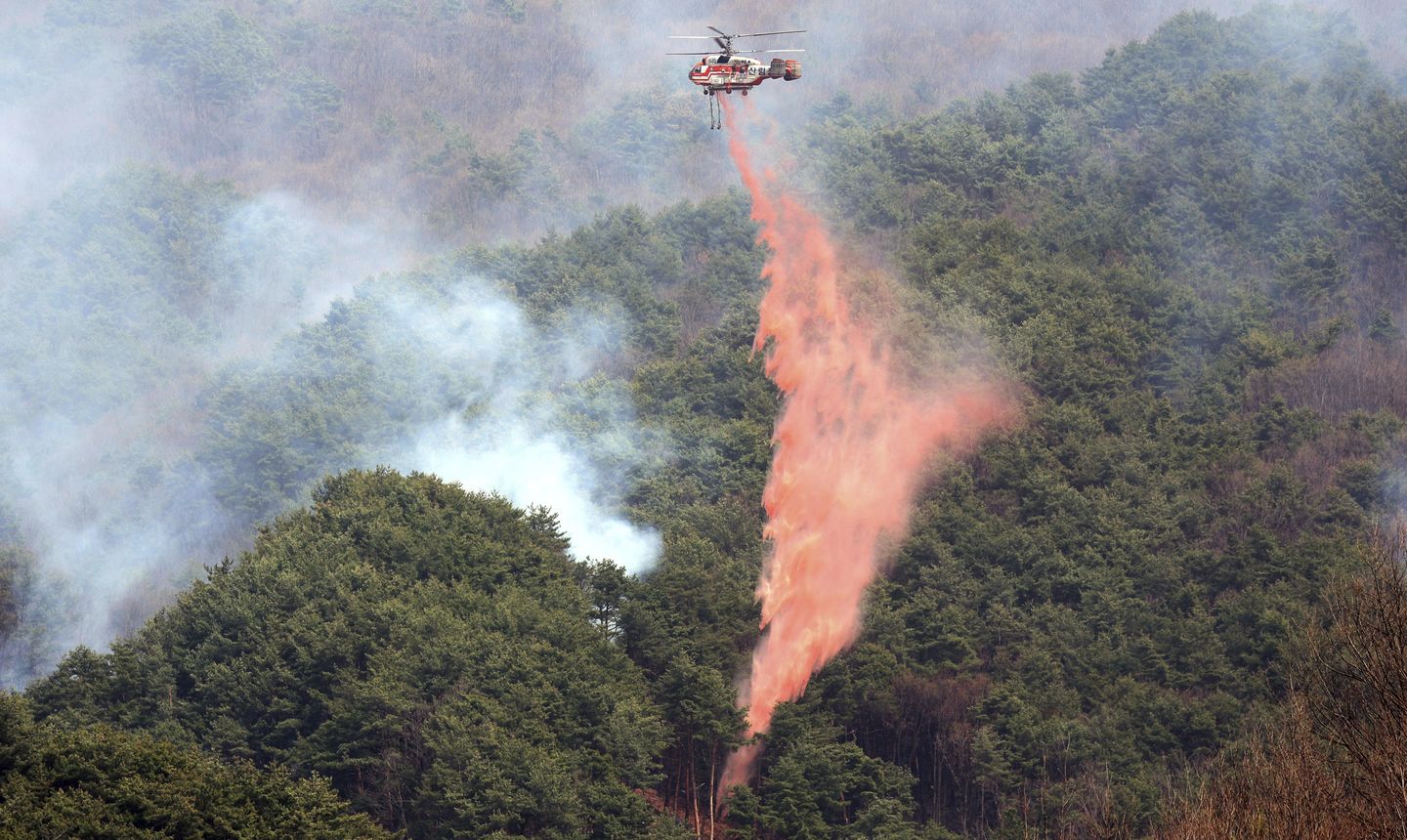
SEOUL, South Korea — South Korea’s attention is shifting from the presidential impeachment crisis to an emergency that has killed 24 and is threatening one of the nation’s top heritage sites.
It also is raising concerns about emergency response, as elites have a strong record of handling national crises but responders at the local level do not.
Wildfires, ignited in an unseasonably dry March and driven by strong winds, broke out on Friday some 112 miles southeast of Seoul. More than 47,000 acres of woodland have been consumed.
The death toll stands at 24, including the pilot of a firefighting helicopter that crashed Wednesday.
Acting President Han Duck-soo called the wildfires “the worst ever” and demanded “all-out efforts” to contain them.
The National Fire Service is operating at its highest emergency level, and thousands of armed forces personnel have been deployed, along with helicopters. U.S. forces in Korea also are joining the firefighting efforts.
On Tuesday, the fires destroyed Goeun-sa, a Buddhist temple that dates to 681 AD. The temple’s national treasures were removed before the structure was consumed, but an even greater threat to Korea’s heritage looms.
On Wednesday, blazes had advanced to less than five miles from Andong Hahoe Village. Its 200 residents have been advised to evacuate, while firefighters mass to defend the site, spraying down buildings and trees.
Hahoe is the country’s largest single cluster of hanok — traditional, wooden cottages — and is one of only two such villages in the country designated UNESCO World Heritage Sites.
Since the mid-1960s, when South Korea initiated a high-speed national development program, traditional housing has been almost entirely razed to clear land for modern residential, commercial and industrial projects.
Geography should assist firefighting efforts.
“It’s in a bend of the Nakdong River, protected on almost three sides and hopefully that will protect it,” said David Mason, an American expert on Korean folk and religious traditions. But he worried that the village, as well as two more of South Korea’s 14 UNESCO World Cultural Heritage sites, are at risk from the fires.
Korea’s killer class divide
The split between response for national versus local emergencies is exemplified by decades of crises.
In 1997, South Korea teetered on the verge of bankruptcy, requiring the International Monetary Fund’s then-biggest bailout. So effective were subsequent, government-driven reform efforts that the national economy didn’t suffer a recession until the COVID-19 pandemic in 2020.
Korea was the second nation struck by that pandemic, after China. Yet Seoul mastered the crisis with one of the lowest international death tolls and without conducting a single lockdown.
Localized crises have not been handled as well by emergency responders.
The sinking of the ferry Sewol in 2014 killed 304, mainly children. The Coast Guard was slammed for its poor response.
In 2022, 159 were killed in a Halloween crowd crush in Itaewon, a Seoul entertainment district. Police had not deployed to control the crowds, as they had not been invited in by local authorities.
The problem is deep rooted. Ancient Korea valued the scholar-aristocrat — which transformed into today’s administrative class — over the man of action.
In South Korea, politicians, bureaucrats, academics and legal-medical professionals enjoy the kind of power and prestige that blue-collar responders who are both empowered and often regarded as heroes in the West – such as soldiers, police and firefighters — lack.
That stifles initiative.
“Inter-agency cooperation is really bad, so for things to work, you need a strong figure at the top,” said Michael Breen, Seoul-based author of “The New Koreans.” “When there is a disaster, presidents have to put on a yellow jacket to direct emergency services, even though they know nothing about it, as the heads of the various services don’t have the inclination or systems to cooperate with one another.”
The 2010 shelling of a South Korean island by North Korea exemplified such lack of empowerment.
“The commander on the ground did not have the authority to react,” Mr. Breen said. “They had to change the rules of engagement afterward to allow local commanders to retaliate.”
Lack of social status also affects professional development and empowerment.
“Elites are highly respected,” said Yang Sun-mook, an entrepreneur and former adviser to the opposition Democratic Party of Korea. “In areas like crisis response, emergency responders are not respected, which affects their budgets and social status.”
As a result, “elites are good at their jobs; non-elites are not good,” he said.
Status is jealously guarded. Junior doctors are striking to maintain a ceiling on entries to medical schools, while prosecutors have jealously guarded their privileges across multiple administrations.
Law enforcement exemplifies the division between elites and non-elites, Mr. Yang said. Korean prosecutors are tasked with the kind of investigative roles undertaken by detectives in many other countries, leaving police with “menial” work, he said.
There is one drawback for elites: accountability is pushed up the hierarchy – sometimes to the very top.
“During the [pre-democratic era], when there was a disaster, the government would blame the working level,” Mr. Yang said. “People got fed up with that, so now in any disaster, the public looks up to the top.”
Many believe that the sinking of the Sewol was the first milestone in the downfall of then-President Park Geun-hye, who would later be impeached and jailed.
















